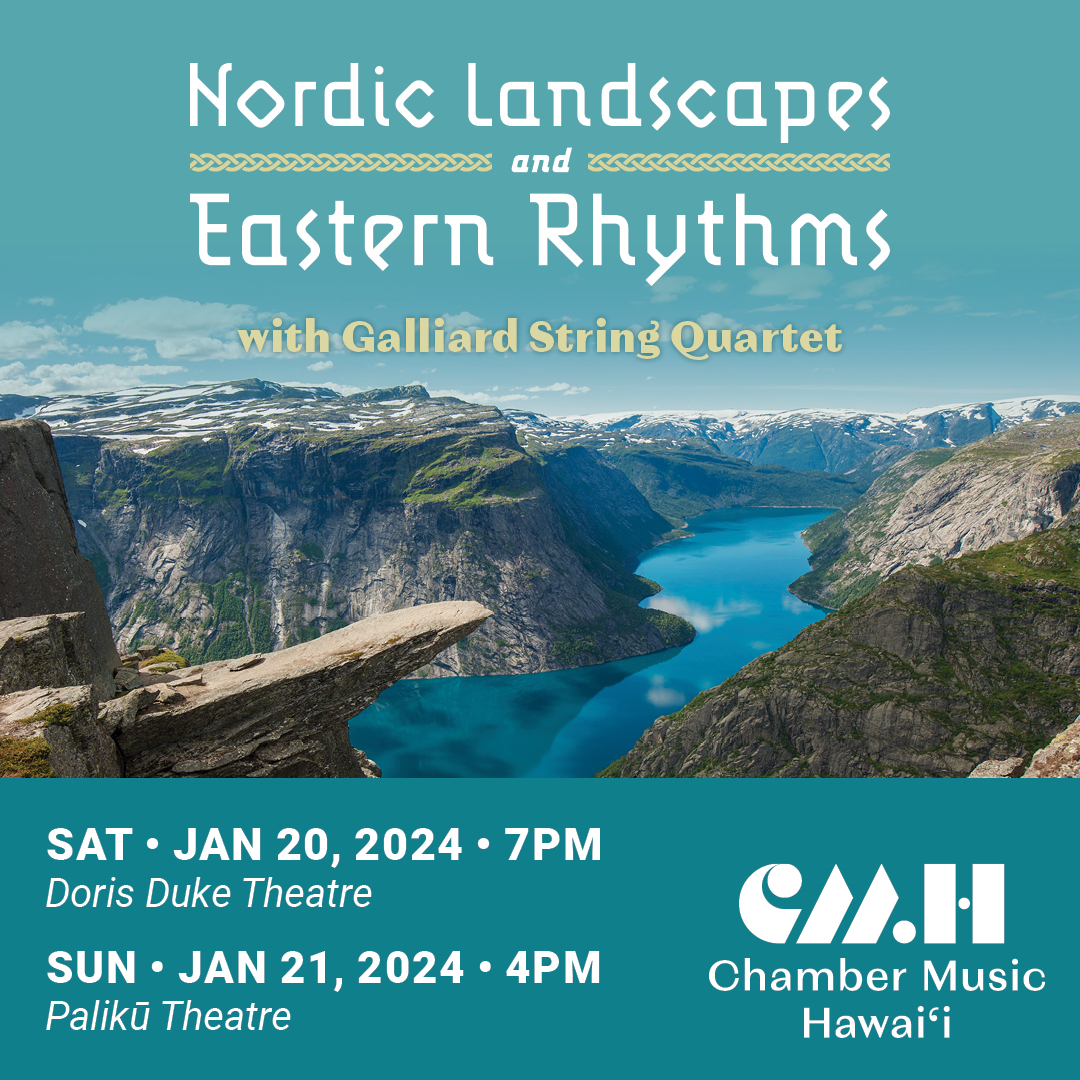
- This event has passed.
Nordic Landscapes and Eastern Rhythms: Palikū Theatre
January 21 @ 4:00 pm – 6:30 pm

$35 General Admission
Discover the captivating sounds of Dvořák’s “American” String Quartet in F Major, Op. 96, as they invoke the essence of America’s vast landscapes in the enchanting second movement, “Lento.”
Journey into the visionary world of Bartók’s String Quartet No. 4, where intriguing harmonies and rhythmic patterns intertwine, captivating the imagination with Eastern rhythms and bold creativity.
Unleash your emotions as Grieg’s passionate String Quartet in G minor, Op. 27, embraces you with its romantic allure and heartfelt melodies, beautifully evoking the essence of Nordic landscapes.
This program is dedicated in memory of Peter Cushman Lewis
Program Notes
Written by Hayden Hawkins
Béla Bartók (1881-1945)
String Quartet No. 4 (1928)
Just over a century ago as a revolution in harmonic theory was occurring as a result of Arnold Schoenberg’s work on twelve-tone serialism, composers such as Béla Bartók were leading a similar but distinctly separate push from classical tonality, pushing the boundaries of the performers and instruments they wrote for in the process. The Hungarian-born composer’s String Quartet No. 4 is a brilliantly symmetrical work that boasts a modern sound despite the lack of any true twelve-tone atonalism. Bartók utilizes non-traditional harmonic methods to express a sound very clearly inspired by Hungarian folk music.
This five-movement work is built around a meta-structural arch, wherein the odd-
numbered movements are each about the same runtime, with the even-numbered pair following this rule while being a bit shorter. Expanding this symmetry further, there are similar melodic elements in the tense first and fifth movements, as well as shared musical ideas across the hurried second and fourth movements, all centered around the third movement’s slower tempo and emotional crux.
In addition to the use of a wide array of techniques available to bowed strings, the
fourth movement is exclusively played pizzicato, or plucked. But notably for the first time in his music Bartók calls for particularly aggressive snap pizzicato, where the strings are plucked with such ferocity that they hit the fingerboard upon recoil. Though a misnomer, this technique is sometimes referred to as Bartók Pizzicato for its prominent feature in this work.
Antonín Dvořák (1841-1904)
String Quartet in F major, op. 96 “American” – II. Lento (1893)
When tracking the most often performed and most popular chamber music, a great number of romantic era compositions inevitably dot the list, but very frequently the greatest common denominator across any of these compilations is Dvořák’s “American” String Quartet in F major. This now quintessential piece of string chamber repertoire was composed during Dvořák’s time in Spillville, Iowa while on break from his tenure at the then recently founded American Conservatory of Music in New York. It was a particularly productive summer for the Czech composer, notably producing his renowned Symphony No. 9 “From the New World” in addition to this work.
Scattered throughout the whole quartet are musical devices evocative of America, such as folk-esque melodic figures and rhythmic motions seemingly inspired by African American and Native American music being the most obvious. While still utilizing some of these devices, the second movement, Lento (slow), is more centered around feelings of longing for Dvořák’s Bohemian homeland during his visit abroad. A great majority of the movement is accompanied by a flowing arpeggio figure traded between the strings, as smooth, pensive melodies paint a picture of a Czech man’s homesickness in an unfamiliar land.
Edvard Grieg (1843-1907)
String Quartet in G minor, op. 27 (1878)
Hailing from the frigid fjords of Western Norway, Edvard Grieg cemented a legacy in romantic music as he worked to bring Nordic folklore and vocal traditions to a wider audience. His efforts still permeate our modern popular culture thanks to the global acclaim of music such as his incidental setting of Ibsen’s Peer Gynt, but compositions of that scale are actually quite limited in the Grieg oeuvre. A great deal of his artistic output was devoted to more intimate solo piano and vocalist works, only completing two string quartets in his lifetime amongst a small handful of other chamber works.
Grieg’s first go around at a string quartet stands out for its rich harmonic texture,
making frequent and indulgent use of multiple-stops, or, bowing multiple strings on the instrument simultaneously. When and how to utilize double-stops is often a balancing act in composition, as there are generally tradeoffs between available dynamics and clarity of sound as you expand the breadth of the strings. But Grieg manages to conquer these minutiae in his String Quartet in G minor, producing soundscapes as rich as Nordic topography throughout the rapid first movement and beyond. The listener is guided through dramatic and joyful melodies across the second and third movement, giving way to a rapid finale.
Concert Sponsor

